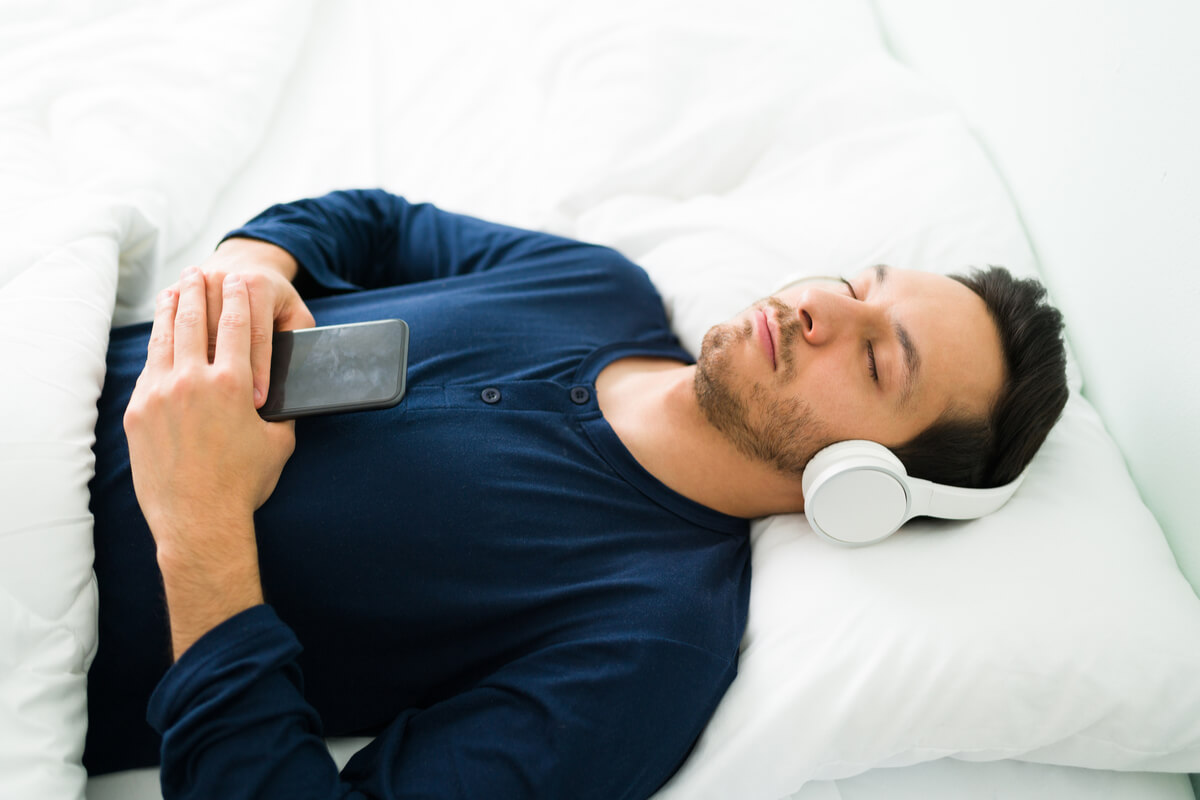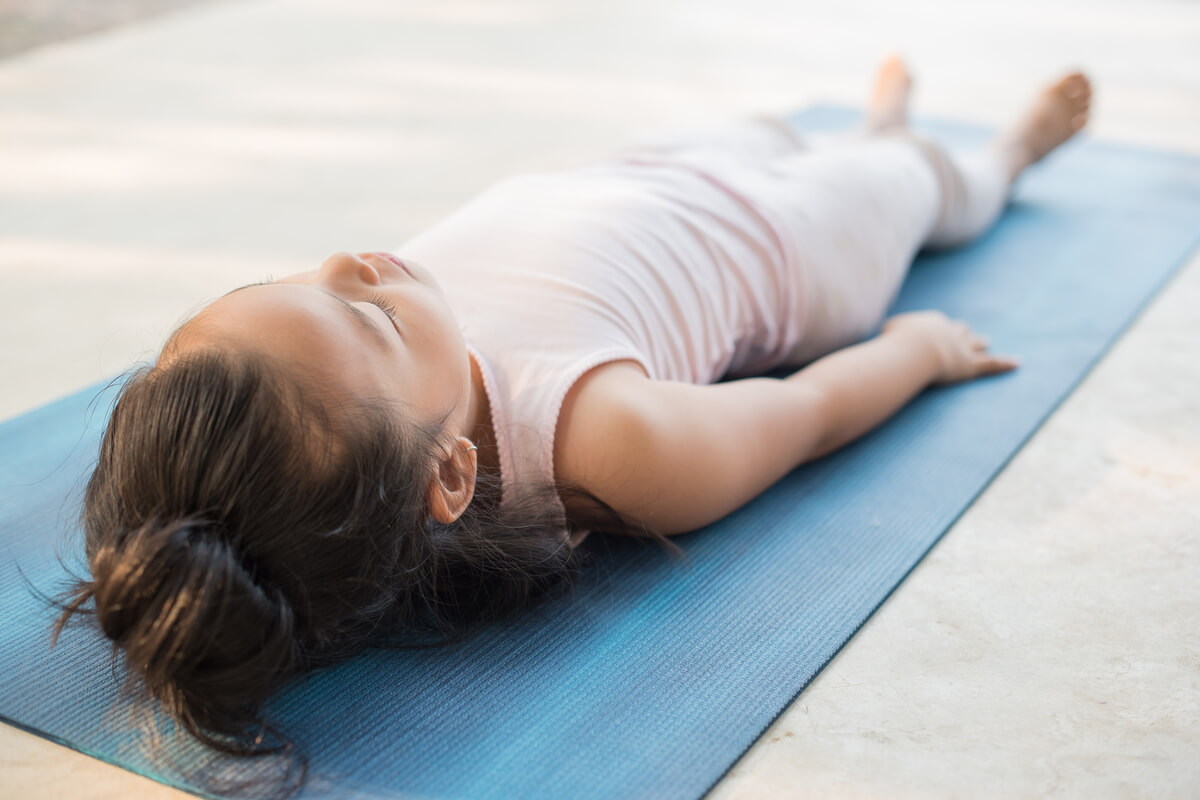What is progressive muscle relaxation?
Progressive muscle relaxation (PMR) is a relaxation activity that involves tensing and relaxing consecutive muscle groups. This method, developed in the 1930s, is based on the notion that physical relaxation can contribute to mental relaxation. Practicing PMR is meant to relieve stress, tension, and anxiety. (5) While there are some slight variations, progressive muscle relaxation is generally done while lying down. You begin by contracting (tensing) a group of muscles and then releasing (relaxing) the contraction. (18) Progressive muscle relaxation works through the following muscle groups in order:- Hands
- Biceps
- Triceps
- Forehead
- Eyes
- Jaw
- Tongue
- Lips
- Neck
- Shoulders
- Lower back
- Buttocks
- Thighs
- Calves
- Shins and ankles
- Feet (1)(18)

Progressive muscle relaxation can be done lying down or sitting upright.
Progressive muscle relaxation benefits
Overall, the goal of PMR is to reduce stress felt in the body and mind. Studies have examined progressive muscle relaxation benefits, which include physical and psychological effects. (16)1. Progressive muscle relaxation for anxiety
PMR has been shown to reduce anxiety in different groups of people, including expectant mothers. In a randomized controlled trial in first-time pregnant women, a PMR intervention was associated with decreased levels of anxiety and stress, as well as a reduced risk of postpartum complications. (16) Progressive muscle relaxation has also been researched in individuals with schizophrenia, a psychiatric disorder associated with anxiety, irritability, and depression. A systematic review of trials found that PMR may decrease anxiety and improve social functioning and overall well-being in adults with schizophrenia. (12)2. Progressive muscle relaxation for healthy aging
PMR may contribute to healthy aging via improving mental health. A systematic review that assessed the effect of relaxation methods in older adults found that progressive muscle relaxation had beneficial effects on depression and anxiety symptoms. (10) One trial in elderly women evaluated the effect of PMR on depression levels and attitudes around aging. The intervention group practiced PMR for 30 minutes, three times per week over eight weeks. Compared to the control group, women who completed the PMR intervention had a reduced level of depression and improved scores in adaptation to old age. (6)3. Progressive muscle relaxation for migraine
Individuals with migraine headaches experience pain and associated symptoms such as nausea, mood changes, and sensitivity to light and sound. One trial in individuals who experience over four migraine headaches per month examined the effects of a PMR intervention using a smartphone application. Compared to a control, the PMR intervention was associated with a small to moderate improvement in migraine disability scores. (13)4. Progressive muscle relaxation for pain
Progressive muscle relaxation has been studied in individuals with chronic health conditions to evaluate the effects on disease-related pain. For example, a controlled trial in individuals with type 2 diabetes found that a 12-week PMR intervention improved fatigue and provided pain relief for diabetic neuropathic pain (a complication of diabetes). Mindfulness meditation was also found to improve pain in these individuals. (8) Another randomized controlled trial in advanced cancer patients assessed an intervention that combined PMR with interactive guided imagery (IGI), a visualization technique used in therapy. Compared to the control group, the PMR-IGI intervention group experienced improvements in pain intensity, symptom distress, and emotional symptoms. The researchers concluded that PMR-IGI may be used to help alleviate pain-related distress in terminal cancer patients. (3) PMR has also been found to improve pain and dysfunction in individuals with temporomandibular joint disorders (TMJ) disorders, musculoskeletal disorders that affect the joint connecting your jaw to your skull. (5)5. Progressive muscle relaxation for sleep
Progressive muscle relaxation is one technique used to address insomnia by supporting mental and physical relaxation. (7) Additionally, PMR has been associated with improved sleep quality and reduced fatigue in chronic health conditions that affect sleep, such as multiple sclerosis (MS) (2) and obstructive sleep apnea. (19)6. Progressive muscle relaxation for stress
A randomized controlled trial examined the effect of progressive muscle relaxation on acute psychological stress and unhealthy food intake. The intervention group had increased relaxation and reduced perceived stress following each PMR session. After the eight-week intervention, tension was reduced while mindfulness and relaxation were increased. However, PMR was not associated with changes in food intake or cravings. (11) Various studies have assessed the effects of progressive muscle relaxation on stress in nurses and student nurse interns. The findings suggest that PMR, either alone or combined with listening to music, can improve coping styles and self-reported burnout, (15) stress, and fatigue. (14)
Progressive muscle relaxation can benefit adults and children alike.
7. Progressive muscle relaxation for kids
PMR has also been researched as a stress management and relaxation technique in children. Progressive muscle relaxation for kids is generally safe and may be effective at reducing headaches (9) and managing anxiety and pain related to dental procedures. (17) One eight-week stress management intervention in obese children and adolescents found that the intervention group had a reduced waist-hip ratio and improved school performance compared to the control group. The intervention program combined PMR with guided imagery, deep breathing, and cognitive restructuring, a type of therapy that addresses negative thought patterns. (4)How to do progressive muscle relaxation
To practice PMR, sit or lie down in a comfortable position. Working through the following list, you will focus your attention on one muscle group at a time:- Fists: Clench your hands into fists.
- Biceps: Bend your elbows and tense the bicep muscles.
- Triceps: Straighten your arms, tense the muscles in the back of your arms.
- Forehead: Wrinkle your forehead in a frown.
- Eyes: Close your eyes tightly.
- Jaw: Gently clench your jaw.
- Tongue: Press your tongue against the roof of your mouth.
- Lips: Press your lips together.
- Neck: Gently press your neck back and hold, then bring your head forward towards the chest and hold.
- Shoulders: Shrug your shoulders as high as you can and hold.
- Stomach: Extend your stomach out as much as possible and hold; then suck your stomach in and hold.
- Lower back: Gently arch the lower back up.
- Buttocks: Tighten the muscles in your buttocks.
- Hips: Lift your legs off the floor (or surface you are on).
- Thighs: Tense your thighs by straightening your knee fully and squeezing.
- Calves: Press your toes downward.
- Shins and ankles: Bend your feet up towards your head.
- Feet: Squeeze the foot by curling your toes tightly. (1)(18)
The bottom line
Progressive muscle relaxation is a technique designed to increase physical and mental relaxation. (5) Research suggests that progressive muscle relaxation benefits include improving anxiety, (16) healthy aging, (6) migraine, (13) pain, (3)(8) sleep, (7)(19) stress, (11) and well-being in children. (4) You can try this relaxation technique at home with the instructions and tips in this article.- Anxiety Canada. (2019, April 17). How to do progressive muscle relaxation. https://www.anxietycanada.com/articles/how-to-do-progressive-muscle-relaxation/
- Dayapoğlu, N., & Tan, M. (2012). Evaluation of the effect of progressive relaxation exercises on fatigue and sleep quality in patients with multiple sclerosis. The Journal of Alternative and Complementary Medicine, 18(10), 983–987.
- de Paolis, G., Naccarato, A., Cibelli, F., D’Alete, A., Mastroianni, C., Surdo, L., Casale, G., & Magnani, C. (2019). The effectiveness of progressive muscle relaxation and interactive guided imagery as a pain-reducing intervention in advanced cancer patients: A multicentre randomised controlled non-pharmacological trial. Complementary Therapies in Clinical Practice, 34, 280–287.
- Emmanouil, C. C., Pervanidou, P., Charmandari, E., Darviri, C., & Chrousos, G. P. (2018). The effectiveness of a health promotion and stress-management intervention program in a sample of obese children and adolescents. Hormones, 17(3), 405–413.
- Ferendiuk, E., Bieganska, J. M., Kazana, P., & Pihut, M. (2019). Progressive muscle relaxation according to Jacobson in treatment of the patients with temporomandibular joint disorders. Folia Med Cracov, 59(3), 113–122.
- Gökşin, L., & Aşiret, G. D. (2021). The effect of progressive muscle relaxation on the adaptation of elderly women to depression and old age: A randomised clinical trial. Psychogeriatrics, 21(3), 333–341.
- Institute for Quality and Efficiency in Health Care. (2017). Insomnia: Relaxation techniques and sleeping habits. In InformedHealth.org. Institute for Quality and Efficiency in Health Care. https://www.ncbi.nlm.nih.gov/books/NBK279320/
- Izgu, N., Gok Metin, Z., Karadas, C., Ozdemir, L., Metinarikan, N., & Corapcıoglu, D. (2020). Progressive muscle relaxation and mindfulness meditation on neuropathic pain, fatigue, and quality of life in patients with type 2 diabetes: A randomized clinical trial. Journal of Nursing Scholarship, 52(5), 476–487.
- Jong, M. C., Boers, I., van Wietmarschen, H. A., Tromp, E., Busari, J. O., Wennekes, R., Snoeck, I., Bekhof, J., & Vlieger, A. M. (2018). Hypnotherapy or transcendental meditation versus progressive muscle relaxation exercises in the treatment of children with primary headaches: A multi-centre, pragmatic, randomised clinical study. European Journal of Pediatrics, 178(2), 147–154.
- Klainin-Yobas, P., Oo, W. N., Suzanne Yew, P. Y., & Lau, Y. (2015). Effects of relaxation interventions on depression and anxiety among older adults: A systematic review. Aging & Mental Health, 19(12), 1043–1055.
- Masih, T., Dimmock, J. A., Epel, E., & Guelfi, K. J. (2019). An 8-week relaxation program consisting of progressive muscle relaxation and mindfulness meditation to reduce stress and attenuate stress-driven eating. Applied Psychology: Health and Well-Being, 12(1), 188–211.
- Melo-Dias, C., Lopes, R. C., Cardoso, D. F. B., Bobrowicz-Campos, E., & Apóstolo, J. L. A. (2019). Schizophrenia and progressive muscle relaxation – a systematic review of effectiveness. Heliyon, 5(4), e01484.
- Minen, M. T., Adhikari, S., Padikkala, J., Tasneem, S., Bagheri, A., Goldberg, E., Powers, S., & Lipton, R. B. (2020). Smartphone-delivered progressive muscle relaxation for the treatment of migraine in primary care: A randomized controlled trial. Headache: The Journal of Head and Face Pain, 60(10), 2232–2246.
- Ozgundondu, B., & Gok Metin, Z. (2019). Effects of progressive muscle relaxation combined with music on stress, fatigue, and coping styles among intensive care nurses. Intensive and Critical Care Nursing, 54, 54–63.
- Pelit-Aksu, S., Özkan-Şat, S., Yaman-Sözbi̇R, E., & Şentürk-Erenel, A. (2020). Effect of progressive muscle relaxation exercise on clinical stress and burnout in student nurse interns. Perspectives in Psychiatric Care, 57(3), 1095–1102.
- Rajeswari, S., & SanjeevaReddy, N. (2020). Efficacy of progressive muscle relaxation on pregnancy outcome among anxious indian primi mothers. Iranian Journal of Nursing and Midwifery Research, 25(1), 23–30.
- Sabherwal, P., Kalra, N., Tyagi, R., Khatri, A., & Srivastava, S. (2021). Hypnosis and progressive muscle relaxation for anxiolysis and pain control during extraction procedure in 8–12-year-old children: A randomized control trial. European Archives of Paediatric Dentistry, 22(5), 823–832.
- U.S. Department of Veterans Affairs. (2021, January 25). Whole health library: Progressive muscle relaxation. Veterans Affairs. https://www.va.gov/WHOLEHEALTHLIBRARY/tools/progressive-muscle-relaxation.asp
- Wang, W., He, G., Wang, M., Liu, L., & Tang, H. (2011). Effects of patient education and progressive muscle relaxation alone or combined on adherence to continuous positive airway pressure treatment in obstructive sleep apnea patients. Sleep and Breathing, 16(4), 1049–1057.





